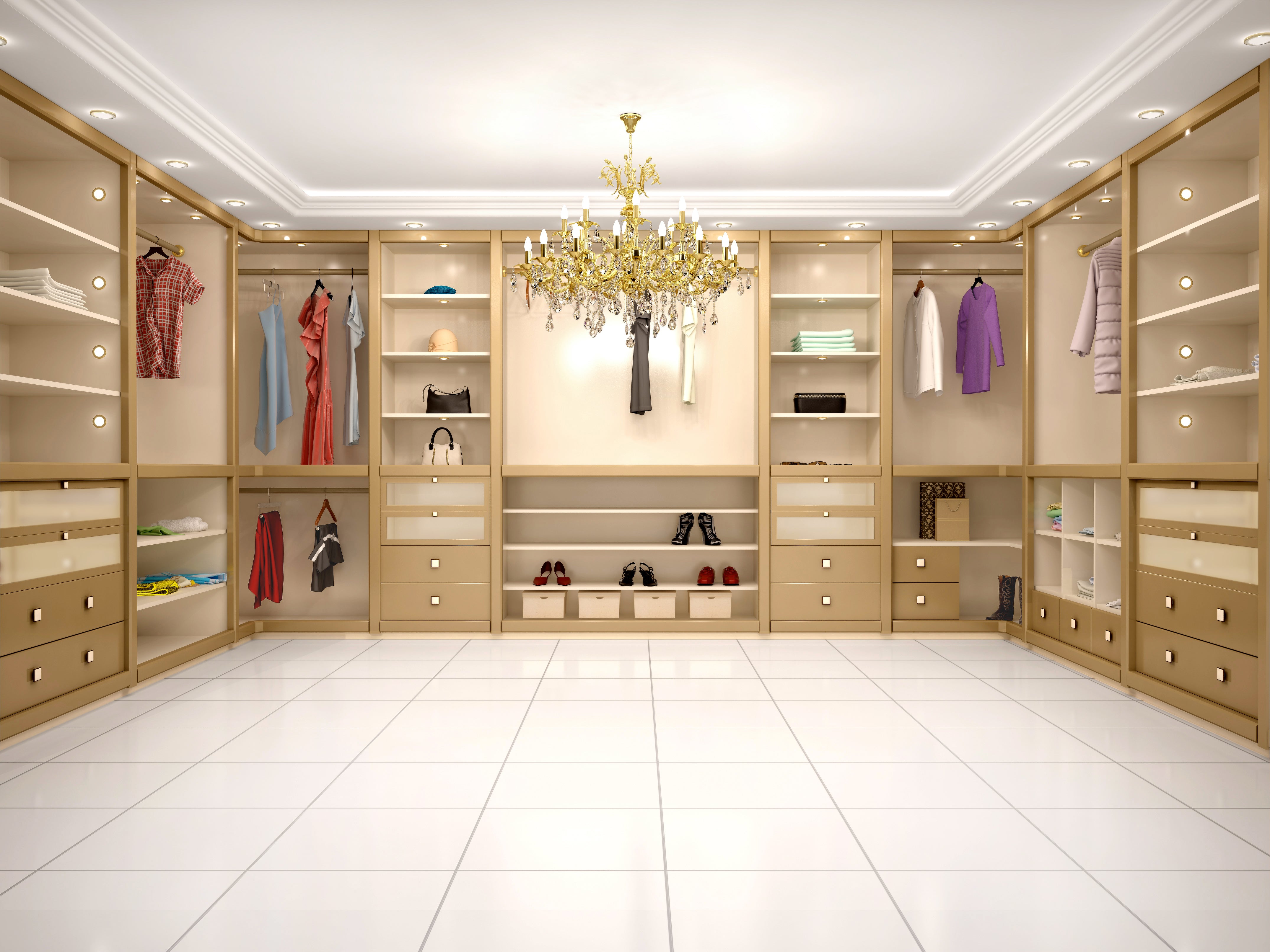Designing the Perfect Walk-In Closet
/GettyImages-872869360-036d4889fdc94cf1800ced94de05065c.jpg)
A walk-in closet is a luxurious addition to any master bedroom, offering ample storage space and a dedicated area to organize your wardrobe. It’s a sanctuary for your clothes, shoes, and accessories, making getting ready a breeze. Designing the perfect walk-in closet involves careful consideration of layout, materials, and essential features to create a functional and aesthetically pleasing space.
Walk-In Closet Layouts
The layout of your walk-in closet significantly impacts its functionality and overall appeal. Choosing the right configuration depends on the size and shape of your closet space. Here are three common layouts to consider:
- L-Shaped: This layout is ideal for smaller spaces and provides ample storage along two walls. It offers a good balance between accessibility and efficiency. A corner shelf or hanging rod can be incorporated for additional storage.
- U-Shaped: This layout maximizes storage space by utilizing three walls. It’s perfect for larger closets and allows for ample hanging space, shelving, and drawers. The U-shaped layout creates a sense of enclosure and privacy.
- Linear: A linear layout is a simple and straightforward option for narrow closets. It features a single wall of storage, typically with hanging rods and shelves. This layout is efficient for smaller spaces and offers easy access to clothing.
Materials for Walk-In Closets
The materials you choose for your walk-in closet influence its durability, aesthetics, and overall ambiance. Here are some tips for selecting the right materials:
- Flooring: Consider durable and easy-to-clean materials like tile, hardwood, or laminate flooring. Carpet can be used, but it may be more susceptible to stains and wear and tear.
- Walls: Painted walls are a versatile and cost-effective option. Wallpaper or textured finishes can add visual interest. For a more luxurious look, consider using wood paneling or shiplap.
- Shelving and Storage: Opt for sturdy materials like wood, metal, or acrylic. Consider the weight of the items you will be storing when choosing shelving materials.
Essential Features for Walk-In Closets
A well-designed walk-in closet should incorporate essential features that enhance functionality and organization. Here’s a list of important elements to include:
- Lighting: Adequate lighting is crucial for visibility and ease of access to your clothes. Install overhead lighting, as well as task lighting for specific areas, such as a dressing table or shoe rack.
- Storage Solutions: A variety of storage solutions is essential for organizing your wardrobe effectively. This includes hanging rods, shelves, drawers, shoe racks, and accessory organizers.
- Organizational Systems: Implementing organizational systems, such as using dividers, baskets, and labels, can streamline your storage and make it easier to find what you need.
Ventilation in Walk-In Closets
Proper ventilation is essential for preventing moisture buildup and musty odors. Consider these tips for ensuring adequate air circulation:
- Vents: Install a vent or fan to exhaust air from the closet. This can be connected to an existing vent or a dedicated duct.
- Openings: Leave small openings in the closet doors or walls to allow for natural air circulation.
- Dehumidifier: If moisture is a concern, consider using a dehumidifier to control humidity levels.
Lighting Solutions for a Walk-In Closet: Master Bedroom Closet Walk In Wardrobe Light

A well-lit walk-in closet is essential for creating a functional and stylish space. Proper lighting not only illuminates your belongings but also enhances the overall aesthetic appeal of your closet.
Types of Lighting for Walk-In Closets
Different types of lighting offer unique advantages for walk-in closets.
- Overhead Lighting: Overhead lighting provides general illumination for the entire closet. This type of lighting is ideal for creating a bright and airy atmosphere. Common options include flush-mount fixtures, chandeliers, and pendant lights.
- Recessed Lighting: Recessed lighting offers a clean and minimalist look, seamlessly integrating into the ceiling. It’s particularly suitable for creating a contemporary feel and maximizing headroom. Recessed lights are often used to illuminate specific areas within the closet.
- Accent Lighting: Accent lighting focuses on highlighting specific features or objects within the closet. This type of lighting can be used to illuminate clothing displays, shoe shelves, or jewelry organizers. Common accent lighting options include track lighting, under-cabinet lights, and spotlights.
Lighting Plan for a Walk-In Closet
A well-designed lighting plan ensures that every area of your walk-in closet is adequately illuminated.
- Clothing Storage: Overhead lighting or recessed lights are suitable for illuminating clothing storage areas. Consider using warm white or soft white bulbs to create a welcoming atmosphere.
- Dressing Area: The dressing area requires brighter lighting to allow for proper visibility when trying on clothes. A combination of overhead lighting and accent lighting can be used to create a well-lit dressing space.
- Shoe Displays: Accent lighting can be used to highlight your shoe collection. Under-cabinet lights or spotlights can be installed beneath shoe shelves to create a dramatic effect.
Choosing the Right Bulbs and Fixtures
Selecting the right bulbs and fixtures is crucial for achieving optimal illumination and energy efficiency.
- Bulb Type: LED bulbs are a popular choice for walk-in closets due to their energy efficiency, long lifespan, and dimmable capabilities. They also produce less heat than traditional incandescent bulbs, making them safer for enclosed spaces.
- Fixture Style: Choose fixtures that complement the overall design of your closet. For a modern aesthetic, consider sleek and minimalist fixtures. For a more traditional look, opt for fixtures with ornate details.
- Color Temperature: Warm white bulbs (2700-3000K) create a cozy and inviting atmosphere, while cool white bulbs (4000-4500K) provide a brighter and more energizing feel. Choose a color temperature that suits your personal preferences and the overall design of your closet.
Layering Light
Layering light is essential for creating a balanced and functional lighting scheme. By combining different types of lighting, you can achieve a dynamic and inviting atmosphere.
- Overhead Lighting: Provides general illumination.
- Recessed Lighting: Illuminates specific areas within the closet.
- Accent Lighting: Highlights specific features or objects.
Maximizing Storage and Organization

A well-designed walk-in closet should not only be aesthetically pleasing but also highly functional, maximizing storage capacity and ensuring effortless organization. By implementing smart storage solutions and adopting a systematic approach to organizing your belongings, you can transform your walk-in closet into a haven of efficiency and style.
Storage Solutions
The key to maximizing storage in your walk-in closet lies in choosing the right storage solutions. Here’s a breakdown of popular options:
- Shelves: Shelves are versatile and provide ample space for storing folded clothes, accessories, and even shoes. Opt for adjustable shelves to accommodate items of varying heights.
- Drawers: Drawers are ideal for storing delicate items, lingerie, and undergarments, keeping them neatly tucked away and free from dust. Consider using drawer dividers to further organize the space.
- Hanging Rods: Hanging rods are essential for storing dresses, shirts, pants, and coats. Utilize double hanging rods to maximize vertical space, allowing you to hang twice the amount of clothes.
- Shoe Racks: Shoe racks are a must-have for any walk-in closet. Choose from tiered shelves, pull-out drawers, or wall-mounted shoe organizers to keep your footwear organized and easily accessible.
Maximizing Vertical Space, Master bedroom closet walk in wardrobe light
Every inch of your walk-in closet is valuable. Utilizing vertical space effectively is key to maximizing storage capacity.
- High Shelves: Install high shelves to store items you don’t access frequently, such as seasonal clothing or out-of-season items.
- Stackable Bins: Utilize stackable bins to store smaller items like scarves, hats, or belts. This allows you to maximize vertical space without sacrificing accessibility.
- Over-the-Door Organizers: These organizers are perfect for storing accessories, shoes, or small items. They take advantage of often-unused space on the back of closet doors.
Organizing Clothing by Category, Color, and Season
A well-organized closet is a joy to use. Consider these strategies:
- Category Organization: Group similar items together. For example, store all tops in one section, bottoms in another, and dresses in a separate area. This allows for easy retrieval and avoids unnecessary searching.
- Color Organization: Arrange clothing within each category by color. This creates a visually appealing and organized closet. It’s also easier to find the specific item you’re looking for.
- Seasonal Organization: Store seasonal items in designated areas or on high shelves. This helps to keep your closet organized and allows you to easily access the items you need for the current season.
Smart Storage Solutions
Incorporate smart storage solutions to enhance accessibility and visibility:
- Pull-Out Drawers: Pull-out drawers are ideal for storing bulky items, like sweaters or jeans, making them easily accessible without having to reach deep into the closet.
- Lazy Susans: Lazy Susans are perfect for storing items on shelves, allowing you to easily rotate and access items without having to move everything around.
- Lighting: Adequate lighting is essential for a functional walk-in closet. Install bright LED lights to illuminate every corner and ensure you can clearly see all your belongings.
